SSS (Sundoko Snake Shape) by Yuki Kawabe
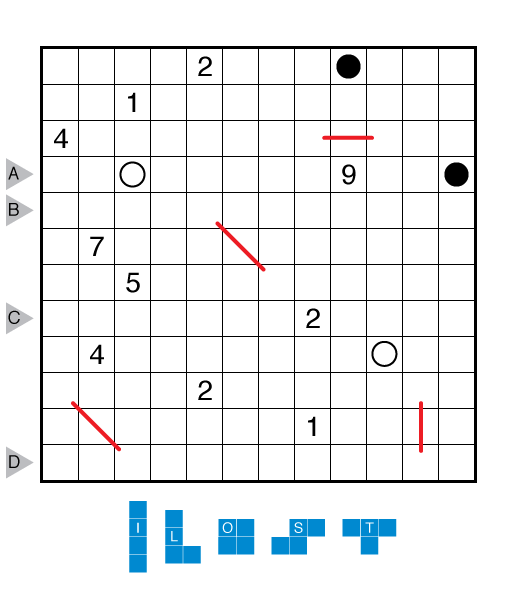
or solve online (using our beta test of Penpa-Edit tools; use tab to shift between shading mode and the linex mode where left click+drag draws lines and right click marks X’s)
Theme: Logical
Author/Opus: This is the 2nd puzzle from guest contributor Yuki Kawabe.
Rules: Combination of Sundoko, Snake, and Shape puzzle styles.
Sundoko: Shade some cells to make sunglasses, consisting of a bridge (a given line, in red) and two lenses made out of orthogonally connected cells that are symmetric with respect to the perpendicular bisector of the bridge. Two lenses may not share an edge, but can intersect at a point. Cells with the bridges are not shaded, except at the bridge ends. Numbers in the grid are unshaded, and indicate the total count of unshaded cells connected vertically and horizontally to the numbered cell, including the cell itself.
Sundoko example:
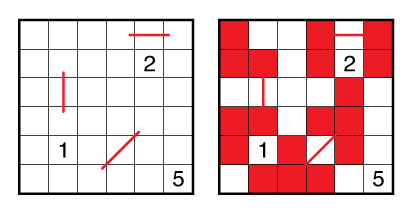
Snake: Shade some cells to create a one-cell wide snake in the grid that does not cross or touch itself, not even diagonally. The snake starts and ends at the black circles and must pass through all white circles.
Snake example:
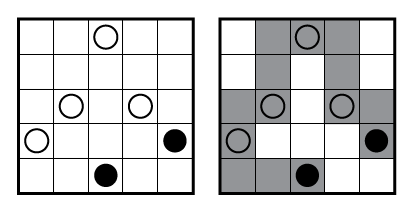
Shape: Place each of the given shapes into the grid exactly once (rotations and reflections allowed). Shapes cannot touch each other, not even diagonally.
Shape example:
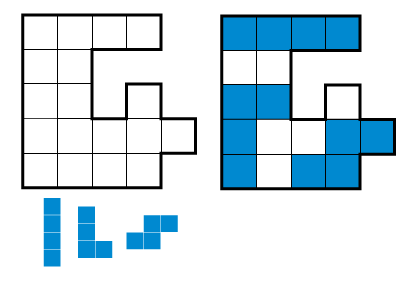
SSS: In SSS, shade some cells to make sunglasses, create a single snake, and place all of the shapes in the grid. Shaded cells of different categories (sunglasses, snake, shapes) cannot share an edge. Number clues referring to unshaded cell counts consider all three categories of objects as shaded cells in this hybrid.
Or see this example:
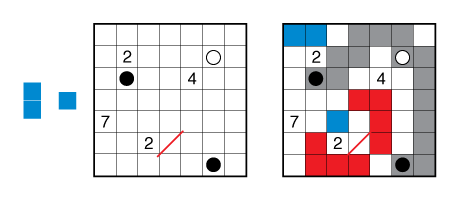
Answer String: Enter the length in cells of each of the shaded segments (sunglasses, snake, and shapes) from left to right for the marked rows, starting at the top. Separate each row’s entry from the next with a comma.
Time Standards (highlight to view): Grandmaster = 3:45, Master = 5:15, Expert = 10:30
Solution: PDF

Looking at the massive rules page, I thought this would be a very messy and confusing puzzle, but it turned out surprisingly intuitive. Great job with this format, I really like it.
One point of confusion though… In “Snake”, the snake can’t touch itself diagonally, correct? It must be that way, otherwise the example puzzle would have multiple solutions, but I wasn’t sure at first.. The rules for “Shape” clearly state that the shapes can’t touch diagonally, but the rules for “Sundoku” state the lenses can? (“Two lenses may not share an edge, but can intersect at a point.”) But when you get to Snake, it’s seemingly left ambiguous, unless I’m missing something (or perhaps snake is considered common enough that it doesn’t need stating?)
Your interpretation is correct. Snake instructions are often tricky to describe (as cells two away on the path can touch diagonally) but I have reverted the language to “does not cross or touch itself, not even diagonally.”
Also, something that may or may not be interesting, it is Sundoko and not Sundoku. The authors clarified that this puzzle is a hybrid of Sunglasses and Kurodoko styles (which itself uses doko meaning “where”, not dokushin meaning “bachelor” as in sudoku). The number clues are doing the same thing as in Kurodoko (sometimes Kuromasu) puzzles.
So this is one case where spelling a puzzle name that looks like sudoku as su[n]doko is correct. I can’t tell you how many Dr. Sudoko messages I’ve gotten in my life though.
How about “two squares of the snake cannot touch diagonally unless they share a three-square snake segment?
On a related note, I would find this to be a much more intuitive puzzle type if two different sunglasses also couldn’t touch each other diagonally. Then the SSS rule could be written simply as “Two squares of different colors may touch each other diagonally, but two squares of the same color can only touch diagonally if they are part of the same sunglasses / shape / snake segment”.
(This would still allow the two “lenses” of the same sunglasses to touch diagonally, but somehow that doesn’t bother me.)